Transporting & Setting Up The Z12: Important Notes
The Z12’s optical tube is so large (at 14” across and 58” long) and heavy (at about 48 pounds) that careful consideration must be taken in moving it.
For one, unlike the Z8 and Z10, the Z12’s tube will not fit across the back seat of most cars; fold-down seats are required.
While the weight may not be bothersome to some people, the sheer width and length mean you are going to have trouble “bear hugging” the scope to move it, and there aren’t really any handles on the tube. Setting the scope precisely on the base without dropping it can also be a little tedious due to the small size of the altitude bearings and the precision with which they must be inserted into the base.
The best option is to obtain aftermarket tube straps or plan on hauling the tube (or entire scope) on a dolly or hand truck.
The particle board base of the Z12 weighs 38 pounds. Moving the base is more awkward than anything else, and the odd position your arms may need to take to lift it may cause you to get tired of carrying it around after a while. You can buy or make a plywood base to significantly reduce the weight for a relatively low cost, and I would highly recommend doing so.
The Optical Tube
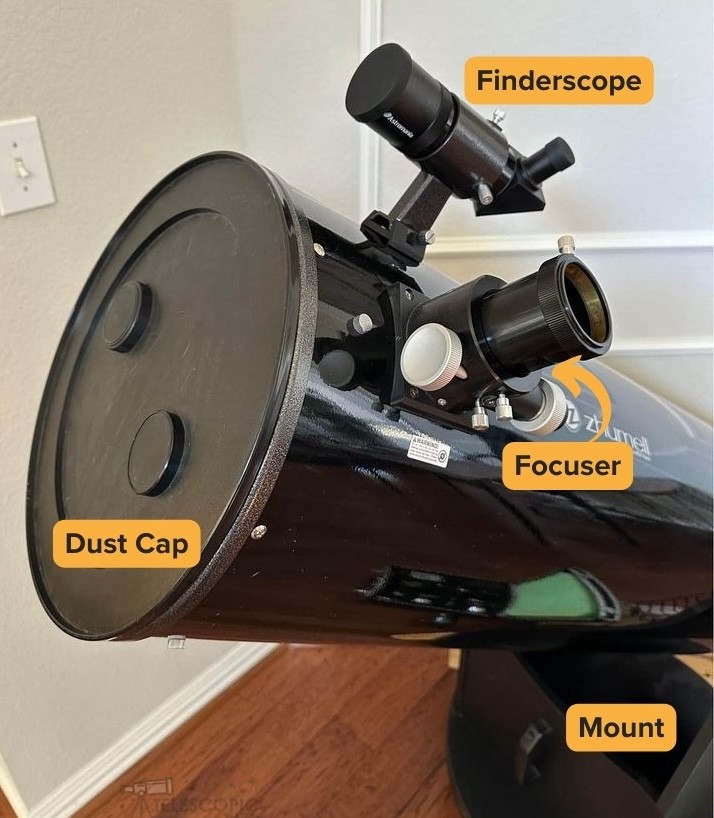
The Z12 is a 12” f/4.9 Newtonian reflector.
Although a 12” f/4 would have been better portability-wise, I understand the designers at GSO chose to keep the scope’s focal ratio as close to f/5 as possible so that we could get away with not using a coma corrector. I would still recommend eventually obtaining a coma corrector for the scope, as coma is definitely visible at the edge of the field of view with low-power eyepieces such as the included 30mm SuperView.
The primary mirror sits on a 9-point flotation-support mirror cell.
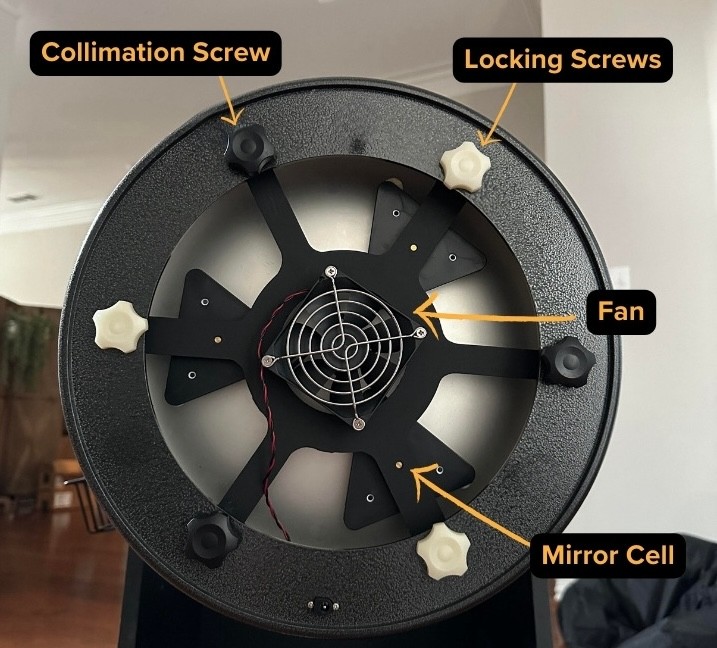
The mirror cell has a cooling fan, which is powered by an AA battery pack that plugs into the fan. I’m not sure where one is supposed to attach the battery pack—no instruction on that is given as far as I’m aware—but I wound up using Velcro to stick it onto the back end of the one I used.
Like with the other Zhumells, the Z12 comes with 3 pointless locking bolts that can be removed with no adverse effect. They directly contact the primary mirror glass and could crack it if you drop the scope by accident with them left in. They serve no functional purpose in the scope.
The focuser on the Zhumells is a high-quality dual-speed 2” Crayford unit, a must for such a large scope with a fast focal ratio.
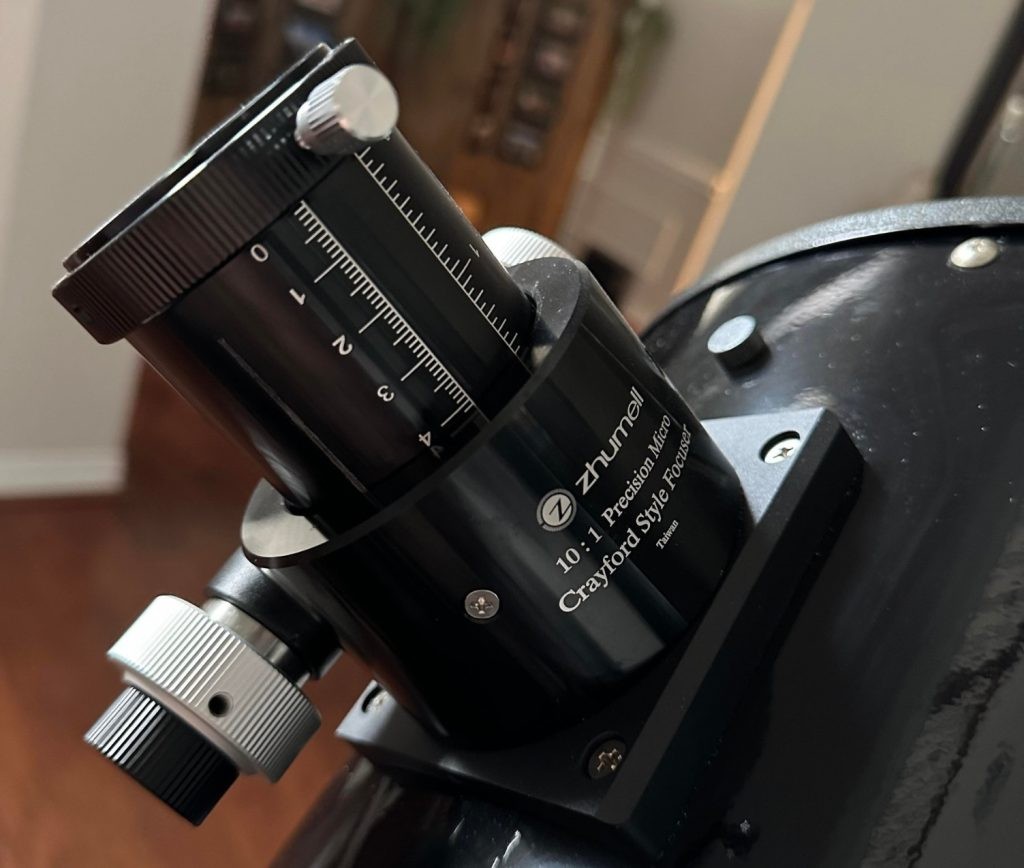
Unlike with the Z8 and Z10, the dust cap on the Z12 actually has raised areas near the middle for us (see Image 1) to lift it off the tube, a nice bonus.
The Simplicity of the Dobsonian Mount
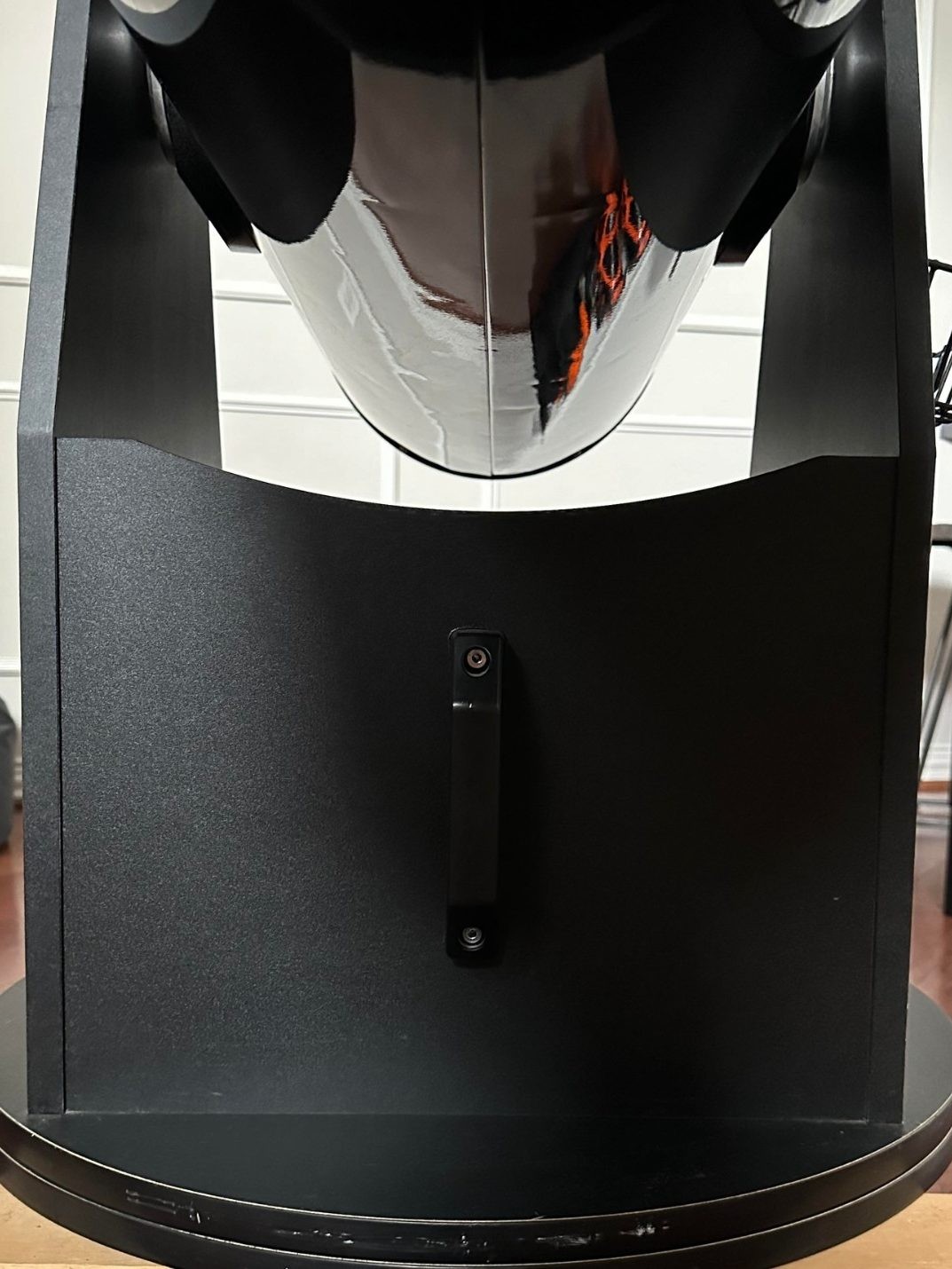
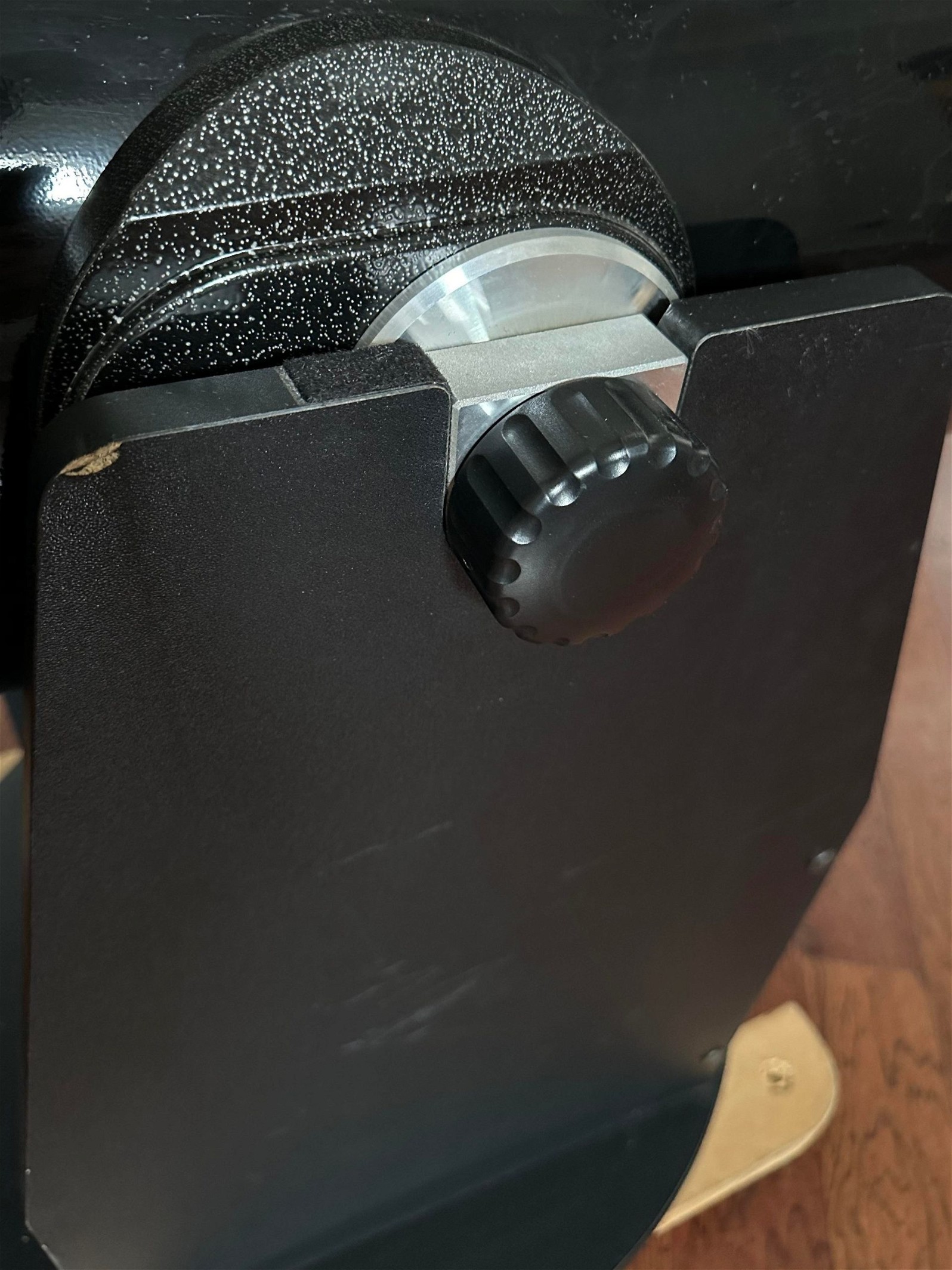
The Z12’s mount works much like the Z8’s.
The altitude bearings, being small and adjustable ball bearings, can be slid up and down the optical tube to help with balance, while the azimuth bearing runs on rollers.
The whole thing is constructed out of laminate-covered particle board and can be assembled with an Allen key in minutes—something you may need to do more than once if you plan on frequently transporting it.
The Accessories
The Z12, like the Z10 and Z8, comes with a 30mm SuperView eyepiece (51x), a 9mm Plossl eyepiece (169x), a laser collimator, and a 9×50 right-angle correct image finderscope.
The included 30mm SuperView eyepiece is decent in my experience, offering a 70-degree apparent field of view (so about 1.375 degrees of true field with the Z12).
However, in addition to the obvious and inevitable coma you’ll see at the edge of the field of view, the SuperView design suffers from a fair amount of edge-of-field astigmatism as well, though coma is a far bigger problem and a far more solvable one.
The included 9mm Plossl is short on eye relief and has a narrow apparent field of view (I question if it’s even 50 degrees), but it works quite well.
I’ve found the included laser collimator to work quite well, provided the laser itself is aligned. Unfortunately, this rarely proves to be the case, but aligning the laser is rather simple and can be done with an Allen key and a makeshift V-block in just a few minutes.
The included 9×50 RACI finderscope, from what I’ve seen, works great, allowing me to directly see many faint fuzzies and dim stars, making locating targets a breeze under even light-polluted skies. Still, you may want a red dot finder or reflex sight to aid you in initially aiming it, as I’ll talk about below.
Should I buy a used Zhumell Z12?
If the price reduction compared to buying new is fair, then go for it. If the particle board mount is damaged or warped, you can make a replacement out of plywood fairly easily—or buy one. Make sure that the optics have no damage and that the coatings are in good shape.
Alternative Recommendations
The Zhumell Z12 and identical Apertura AD12 offer excellent value and performance for the price. But not everyone will be comfortable setting up and transporting a heavy, bulky, solid-tubed 12” Dob, and as such, we’ve picked out a few alternatives that are either smaller or collapse into smaller, lighter pieces.
Under $1000
- Manual Scope: The Apertura AD10/Zhumell Z10/Orion SkyLine 10 boasts the same fantastic features and accessories as the larger Z12 but in a more compact form factor that’s easier to transport and fit into your vehicle, as well as at an attractive price point, allowing you to budget more for accessories. It’s still highly capable and barely bigger or heavier than the 8” version.
- Manual Truss Tube Scope: Explore Scientific 10″ Hybrid Dobsonian has an innovative truss tube design, making it incredibly portable when collapsed into its small cubic form, but it needs various expensive upgrades and a few eyepieces before you can start using it properly, as little is provided and the scope is a bit unoptimized out of the box.
$1200-$2200
- Manual Truss Tube Scope: The Explore Scientific 12″ Truss Tube Dobsonian features a premium dual-speed Crayford focuser like the Z12, smooth bearings, and an all-metal structure that takes up very little space once disassembled, though no eyepieces or finder are provided, and further addons such as a shroud are required for effective performance.
- Manual Truss Tube Scope: The Sky-Watcher 12” FlexTube Collapsible Dobsonian is slightly smaller when collapsed than the Z12 but not much lighter, with basic accessories that may not be enough depending on your preferences; however, its collapsible design makes it quite simple to pack away in your car or a closet if size rather than weight is your main concern.
- Computerized Truss Tube Scope: The Sky-Watcher 10” FlexTube Collapsible GoTo Dobsonian affords both automated and manual tracking and pointing capabilities due to its FreedomFind encoder system, while also providing an easily transportable form factor which is a little bit easier to fit in a small space when condensed than traditional solid-tubed 10” Dobs.
- Computerized Scope: Celestron NexStar Evolution 8 has cutting-edge motorized tracking/pointing control operated either with the provided hand controller or through a WiFi connection and is remarkably small due to its Schmidt-Cassegrain optical architecture plus integrated lithium battery; however, its long focal length restricts the field of view compared to large 10” or 12” Dobs, and it is, of course, a bit lacking in light gathering or resolving power.
Aftermarket Accessory Recommendations
The Z12 comes with a lot of great accessories, but there are a few we’d recommend to enhance your experience even further.
A 6mm “goldline” eyepiece will provide 250x with the Z12, which is a good magnification to use on most nights for the Moon, planets, close double stars, globular clusters, and planetary nebulae. For even more magnification, we’d recommend a 4mm planetary eyepiece for 375x. If you’re looking for a more moderate magnification eyepiece to fit between the included 30mm and 9mm, a 15mm redline (100x) is always a good choice for moderate magnification on the Moon and many deep-sky objects.
For viewing nebulae, a UHC filter is a great way to increase contrast under light-polluted skies. A 2” filter can be threaded onto the included 2” to 1.25” adapter for use with 1.25” eyepieces.
Last but not least, we highly recommend a Telrad or Rigel Quikfinder to accompany the 9×50 finder included with the scope. It’ll make zeroing in on faint fuzzies a whole lot easier.
What can you see with the Zhumell Z12?
The Z12 is capable of showing you a lot. We mean it. Even within the solar system, there’s a ton.
Mercury and Venus will show their phases as in a smaller telescope (that’s all there is to see of them, after all).
The moon is lush with detail, and you’ll definitely want to use the included moon filter – you’ll be dazzled and have trouble seeing anything for a few minutes after viewing if you don’t!
Mars will show quite a few dark regions, as well as the ice cap when it’s near opposition. With some special observing tricks to hide Mars and its glare from the field of view, you may even be able to spot its tiny moons, Phobos and Deimos.
Jupiter’s cloud belts and Great Red Spot show a wealth of detail. Its four large moons are all easily distinguishable as disks with different colors. Ganymede, in particular, might have a bit of a two-toned look—gray on one side with more of a brown patch on the other. This brown spot is known as the Galileo Regio.
Saturn and its rings are simply jaw-dropping through the Zhumell Z12. The rings’ Cassini Division is quite obvious, and on a really good night, you might just be able to make out the Encke Division too. Saturn itself displays cream, beige, and gray cloud belts. More than half a dozen moons are easily visible, and with luck, you may be able to spot the faint Hyperion.
Uranus and Neptune are still the same boring teal and bluish dots that they are in almost any telescope with the Z12, but with the exciting addition of moons. Neptune’s sole large moon, Triton, is fairly easy to spot, while Uranus’ 4 large moons – Titania, Oberon, Ariel, and Umbriel – will require fairly dark skies and a trained eye to see – they’re about as dim as Pluto.
Pluto is actually visible with the Z12 under decent skies – albeit as little more than a dim point. As Pluto will wander among the crowded star fields of Sagittarius for the foreseeable future, you may have a hard time distinguishing it from the stars. Careful observation – either by comparing it with simulations of the surrounding stars or by sketching it and watching for movement over the course of a few days – will be required to be sure you’ve bagged it.
For the best deep-sky views, you’ll really want to bring your Z12 to dark skies; if you can, expect the following:
Galaxies – Most of the Messier catalog galaxies and the brighter NGC ones show detail in some way – be it M31 and M64’s dust lanes, M82’s filaments, M33’s H-II regions, or M51 and M101’s spiral arms. Technically, these targets are all visible in a smaller scope under the right conditions too, but the Z12 really brings them out for even a novice observer. What’s more is that tens of thousands of additional galaxies are visible as faint or barely-noticeable smudges – some billions of light-years away.
Speaking of targets billions of light-years away, a 12” scope can show you a lot of quasars. Around a dozen quasars are brighter than magnitude 15, with the brightest – 3C 273 in Virgo – sitting at magnitude 12.9, which is quite easy under even rather light-polluted skies. PKS 0405-123 in Eridanus is 6.4 billion light-years away! They may appear as nothing more than dim star-like points, but quasars are the most distant objects visible to an amateur telescope, largely due to their extreme brightness compared to regular galaxies.
Globular star clusters – Even the fainter/smaller globulars are resolvable into individual stars. Some begin to take on some individual characteristics—for instance, M13’s dust lanes, M92’s oval-shaped appearance, M4’s loosely arranged stars, and the bright condensed core of M15.
Open star clusters – Open clusters explode into life in Z12, even under city skies. Clusters such as M35, M11, M24, or the Double Cluster glitter with yellow, red, white, and blue stars. The brilliant blue Pleiades are dazzling to the eye – and with effort and dark skies, you may be able to begin to trace the faint reflection nebula that gleams within them.
Emission nebulae – M42 (Orion) and M8 (the Lagoon) have a green-blue color (mainly because our eyes are far more sensitive to blue/green than the reddish-pink light that actually dominates the nebulae) and look almost three-dimensional. You could spend hours on either of these two alone. The Swan Nebula (M16) shows loops of gas beyond the body of the “swan” and looks fabulous, as does the Trifid with its dust lanes. You can navigate around the enormous and complex Veil Nebula for hours with a good UHC or Oxygen-III filter.
Planetary nebulae – Most of the popular planetary nebulae show structure and/or colors in a 12” – ranging from simple rings to complex looping arrangements and generally a teal to deep blue coloration. The smaller planetary nebulae do require good seeing and high magnification to spot detail in, however.

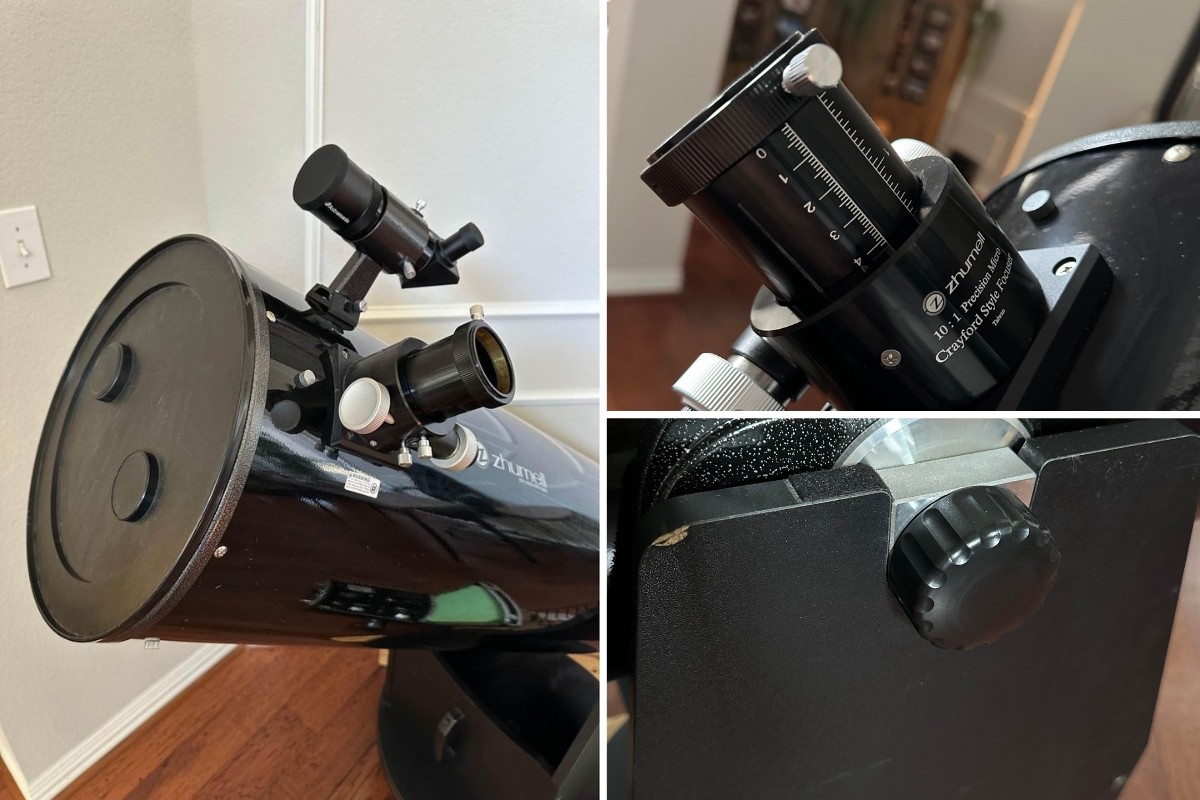
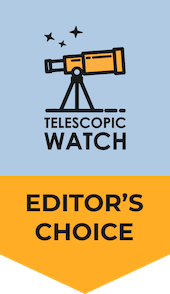

Hi Zane,
I read through your reviews of several telescopes. I’m considering 10” goto dob vs 12” non-goto vs Celestron 8” nexstar. Could you advise on the choice keeping the price aside ?
I looked at your rankings in the price ranges. Aperture is tempting to go for. Do you’ve any review for “Meade 12″ LightBridge Plus Dobsonian” that you can share ?
thanks
Bhaskar
The NexStar has the least impressive views and the least stable mount. I wouldn’t go for that.
A 12″ truss will show you more than the 10″ GoTo but takes a bit longer to set up than the 10″ does. Personally I would go for the 12″ as it will show you a lot more, but you could also get the 10″ and then upgrade to a 14″ or 16″ later….
Thank you Zane for the advice. I’ll go for 12”.